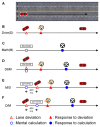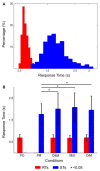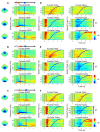Theta and Alpha Oscillations in Attentional Interaction during Distracted Driving
- PMID: 29479310
- PMCID: PMC5811509
- DOI: 10.3389/fnbeh.2018.00003
Theta and Alpha Oscillations in Attentional Interaction during Distracted Driving
Abstract
Performing multiple tasks simultaneously usually affects the behavioral performance as compared with executing the single task. Moreover, processing multiple tasks simultaneously often involve more cognitive demands. Two visual tasks, lane-keeping task and mental calculation, were utilized to assess the brain dynamics through 32-channel electroencephalogram (EEG) recorded from 14 participants. A 400-ms stimulus onset asynchrony (SOA) factor was used to induce distinct levels of attentional requirements. In the dual-task conditions, the deteriorated behavior reflected the divided attention and the overlapping brain resources used. The frontal, parietal and occipital components were decomposed by independent component analysis (ICA) algorithm. The event- and response-related theta and alpha oscillations in selected brain regions were investigated first. The increased theta oscillation in frontal component and decreased alpha oscillations in parietal and occipital components reflect the cognitive demands and attentional requirements as executing the designed tasks. Furthermore, time-varying interactive over-additive (O-Add), additive (Add) and under-additive (U-Add) activations were explored and summarized through the comparison between the summation of the elicited spectral perturbations in two single-task conditions and the spectral perturbations in the dual task. Add and U-Add activations were observed while executing the dual tasks. U-Add theta and alpha activations dominated the posterior region in dual-task situations. Our results show that both deteriorated behaviors and interactive brain activations should be comprehensively considered for evaluating workload or attentional interaction precisely.
Keywords: alpha; dual-task; electroencephalogram (EEG); independent component analysis (ICA); interactive attention; stimulus onset asynchrony (SOA); theta.
Figures





References
LinkOut - more resources
Full Text Sources
Other Literature Sources
Miscellaneous

